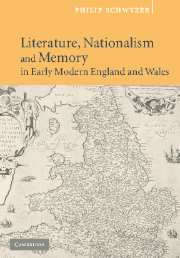Book contents
- Frontmatter
- Contents
- Acknowledgments
- Note on the text
- Introduction: remembering Britain
- 1 Spenser's spark: British blood and British nationalism in the Tudor era
- 2 Bale's books and Aske's abbeys: nostalgia and the aesthetics of nationhood
- 3 “Awake, lovely Wales”: national identity and cultural memory
- 4 Ghosts of a nation: A Mirror For Magistrates and the poetry of spectral complaint
- 5 “I am Welsh, you know”: the nation in Henry V
- 6 “Is this the promised end?” James I, King Lear, and the strange death of Tudor Britain
- Bibliography
- Index
2 - Bale's books and Aske's abbeys: nostalgia and the aesthetics of nationhood
Published online by Cambridge University Press: 07 December 2009
- Frontmatter
- Contents
- Acknowledgments
- Note on the text
- Introduction: remembering Britain
- 1 Spenser's spark: British blood and British nationalism in the Tudor era
- 2 Bale's books and Aske's abbeys: nostalgia and the aesthetics of nationhood
- 3 “Awake, lovely Wales”: national identity and cultural memory
- 4 Ghosts of a nation: A Mirror For Magistrates and the poetry of spectral complaint
- 5 “I am Welsh, you know”: the nation in Henry V
- 6 “Is this the promised end?” James I, King Lear, and the strange death of Tudor Britain
- Bibliography
- Index
Summary
Since the Tudor era, blood has remained central to most versions of English and British nationalism. As Edmund Burke would explain in his Reflections on the Revolution in France, “we have given to our frame of polity the image of a relation in blood.” Yet, in spite of his commitment to the figure of the nation-as-family, Burke recognizes that blood alone is never enough. Indeed, however essential it may be, it remains only an “image.” What really binds the nation together, then, is something still more fundamental: a mode of collective introspection, a way of seeing. Like Narcissus, the nation finds its proper object of contemplation in itself, and its survival depends on ceaselessly sustaining that self-constituting gaze. Therefore, argues Burke, it must always be sure of liking what it sees. “To make us love our country, our country ought to be lovely.”
Disgusted by what he saw as Burke's dainty aestheticism in the face of an epoch-making struggle, Thomas Paine fired back a bitter riposte: “he pities the plumage, but forgets the dying bird.” The lines were thereby drawn in a controversy that has persisted into the present day. Nationalists the world over have come down firmly on Burke's side of the question. A host of patriotic songs, from “America the Beautiful” to “O Lovely Zimbabwe,” testify to the central place of the aesthetic in nationalist thought and feeling. Scholars of nationalism, on the other hand, have tended to follow Paine in minimizing or dismissing the question of beauty.
- Type
- Chapter
- Information
- Publisher: Cambridge University PressPrint publication year: 2004



